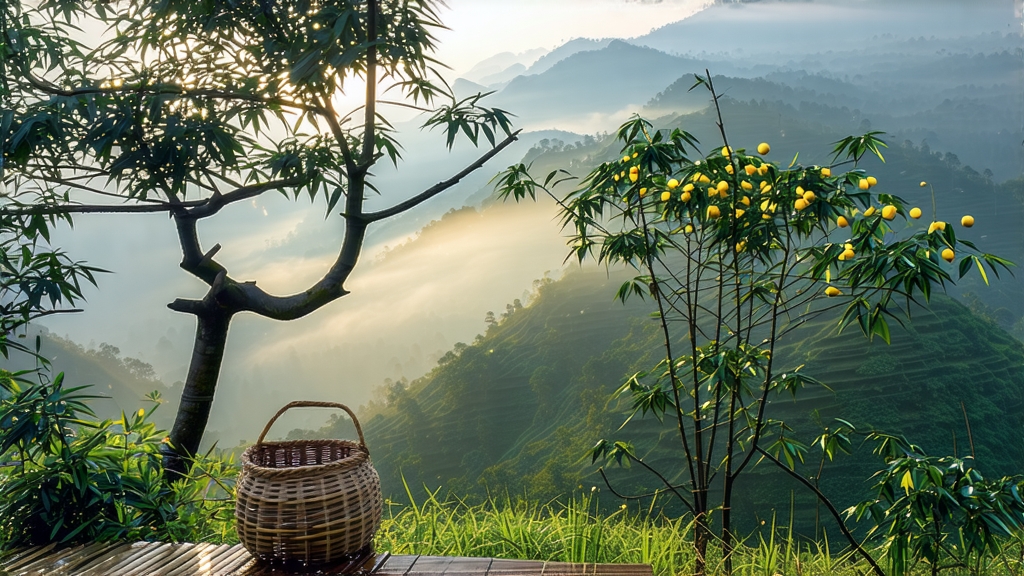
Tucked high on the northern rim of the Sichuan Basin, where the Tibetan Plateau tumbles into lush hills, lies Meng Ding Mountain, a name that has echoed through Chinese tea annals since the Tang dynasty. It was here, legend claims, that the Buddhist monk Wu Li-zhen planted the first seven tea bushes in 53 BCE, convinced that the mist, altitude and mineral-rich soil could coax divinity into a leaf. Twenty-one centuries later those same slopes still produce Meng Ding Huang Ya—Meng Ding Yellow Bud—an endangered style that once traveled in bamboo tubes to the imperial court, its down-covered tips glowing like pale gold in candlelight. Today only a few hundred kilograms leave the mountain each spring, most claimed by collectors who value the tea less for its rarity than for its quiet miracle of flavor: a silky broth that smells of fresh chestnut, steamed corn and mountain orchid, finishing with a cool, almost menthol sweetness that lingers at the back of the throat.
Although yellow tea as a category emerged during the Ming dynasty, Meng Ding Huang Ya predates the technique that defines it. Early Song-era records describe a “steamed and pressed” tribute tea from Meng Ding, but the deliberate “sealed yellowing” step—slow, non-enzymatic oxidation that turns the leaf from green to straw-gold—was perfected here in the 16th century by monks seeking to remove the grassy edge of spring green tea while preserving its antioxidant brilliance. The result was a new chromatic paradigm: not green, not oolong, not yet black, but a luminous third color that the Kangxi Emperor declared “the shade of morning sun on palace tiles.”
The cultivar itself is a local heirloom known as “xiao ye zhong,” small-leaf sinensis famous for its high bud-to-leaf ratio and a unique amino-acid profile that translates into umami depth. Picking begins at Qingming, when two inches of night mist still cling to the valley. Only the unopened bud and the single adjacent leaf are plucked, a standard called “yi ya yi ye” that yields roughly 80,000 shoots per kilogram of finished tea. Workers wear cotton gloves to prevent bruising, and the leaf is carried in shallow bamboo trays lined with hemp cloth; anything deeper would crush the hairs that give the dry tea its silvery shimmer.
Withering is done outdoors for exactly 38 minutes—long enough for surface moisture to evaporate, short enough to keep internal cells intact. The leaf is then pan-fired in woks heated to 160 °C, a step called “sha qing” that kills green enzymes and sets the stage for yellowing. Here Meng Ding diverges from green-tea orthodoxy: while Longjing is pressed flat and Dragon-well fragrance is locked in with immediate cooling, Meng Ding Huang Ya is wrapped. While still warm, the leaf is piled into linen bundles the size of a monk’s alms bowl and placed in a humid cellar beneath the temple. For the next 72 hours the bundles are turned every four hours, allowing residual heat and moisture to re-oxidize the leaf edges slowly, turning them ochre. The process is monitored by scent: when the pile exhales the aroma of fresh pumpkin, the yellowing is complete. A second, gentler firing at 90 °C reduces moisture to 5 %, curling the bud into the shape of a tiny fishhook, its tip tipped with gold.
Because the leaf is so young and the cell walls remain delicate, brewing Meng Ding Huang Ya demands restraint. The classic Sichuan method uses a tall, thin glass called “bei zhong” that allows the buds to stand upright like miniature bamboo shoots. Three grams—about forty buds—are dropped into 250 ml of water cooled to 80 °C. The first infusion, thirty seconds, releases a pale champagne liquor and a scent that connoisseurs liken to hot stone fruit. The buds float, then sink in slow motion, a choreography known as “three ups and three downs.” The second infusion, forty seconds, is the most aromatic, revealing a note of linden honey. By the third, the leaf opens fully, yielding a buttery texture and a finish of raw almond. Professional cuppers look for “huang tang huang ye”—yellow soup, yellow leaf—and a ring of tiny bubbles that clings to the rim of the glass, evidence of the amino-acid surge unique to yellow tea.
To appreciate the tea’s architecture of flavor, many drinkers employ the “gongfu” approach. A 120 ml gaiwan is warmed, then filled to